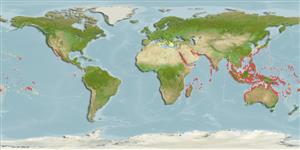Common names from other countries
Environment: milieu / climate zone / depth range / distribution range
Ekologi
; kisaran kedalaman 0 - 20 m (Ref. 348). Tropical
Indo-West Pacific and the Mediterranean: from East Africa, to Melanesia; north to South China and Taiwan Province of China and south to Indonesia; south and eastern parts of the Mediterranean. Tropical to subtropical climates.
Length at first maturity / Size / Weight / umur
Maturity: Lm ? range ? - ? cm Max length : 12.0 cm SHL jantan/; (Ref. 348); common length : 8.0 cm jantan/; (Ref. 348)
Locally collected at low tide by coastal people when abundant (Ref. 348). Attached by their strong byssus to hard substrates where mud occurs, with the shell vertically disposed and the dorsal margin lying on the rock surface, or to the underside of ledges and boulders. Often in dense colonies (maximum recorded density of 870 individuals/m^2), sometimes forming mixed natural beds with Isognomon isognomum. Littoral and sublittoral (Ref. 348).
Life cycle and mating behavior
Kematangan | Reproduksi, perkembang biakan | Pemijahan | telur-telur | Fecundity | Larva
Members of the class Bivalvia are mostly gonochoric, some are protandric hermaphrodites. Life cycle: Embryos develop into free-swimming trocophore larvae, succeeded by the bivalve veliger, resembling a miniature clam.
rujukan utama
Acuan | Koordinator | mitra
Poutiers, J.M. 1998. (Ref. 348)
Status IUCN Red List (Ref. 130435)
status CITES (Ref. 108899)
Not Evaluated
Not Evaluated
penggunaan manusia
| FishSource |
Alat, peralatan
informasi lanjut
Umur / Saiz
Pertumbuhan
panjang-berat
panjang-panjang
Morfologi
Larva
Kelimpahan
Sumber internet
Estimates based on models
Preferred temperature
(Ref.
115969): 22.1 - 29.3, mean 28.2 (based on 4092 cells).
keancaman
Low vulnerability (10 of 100).
kategori harga
Unknown.
